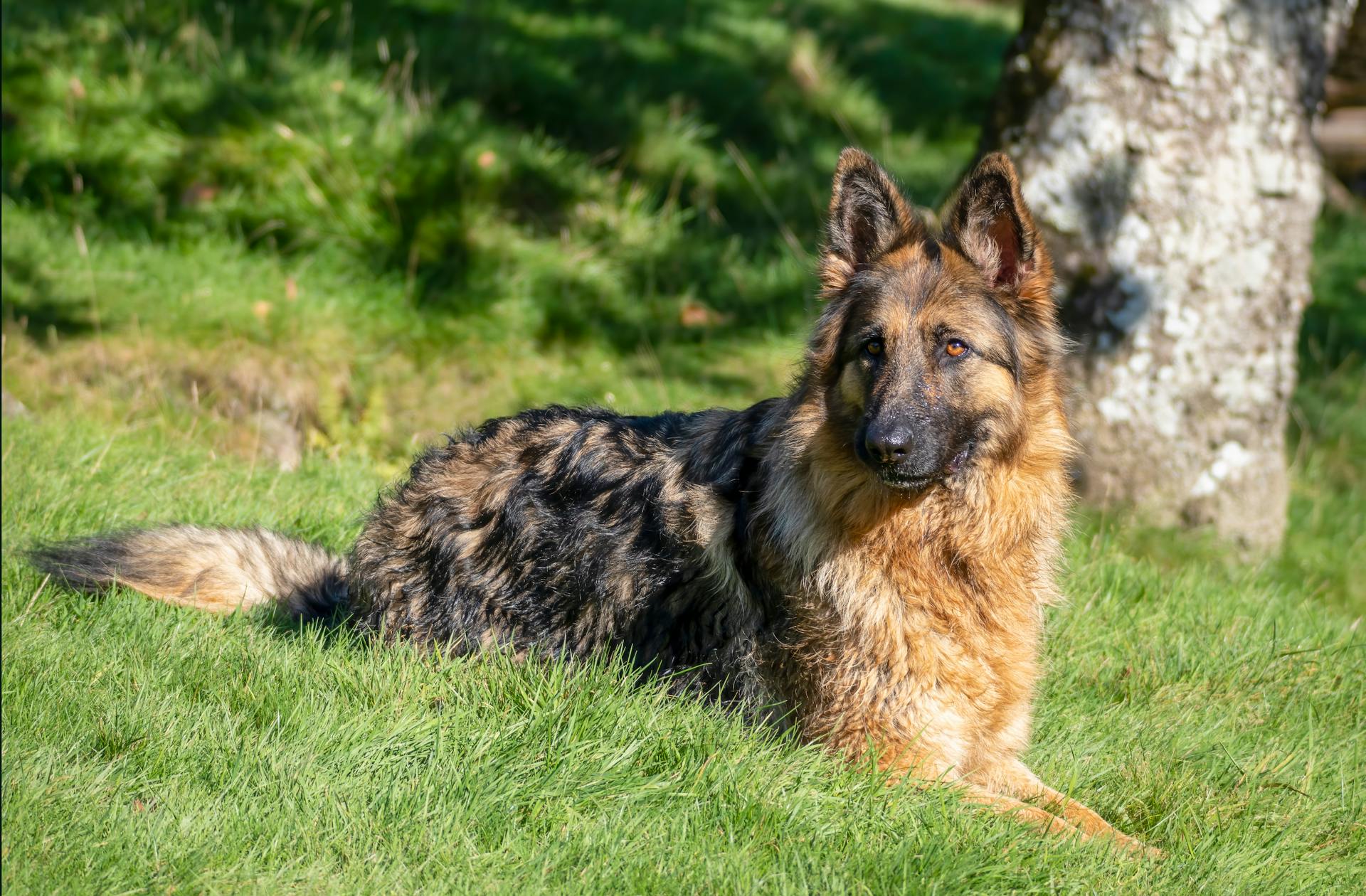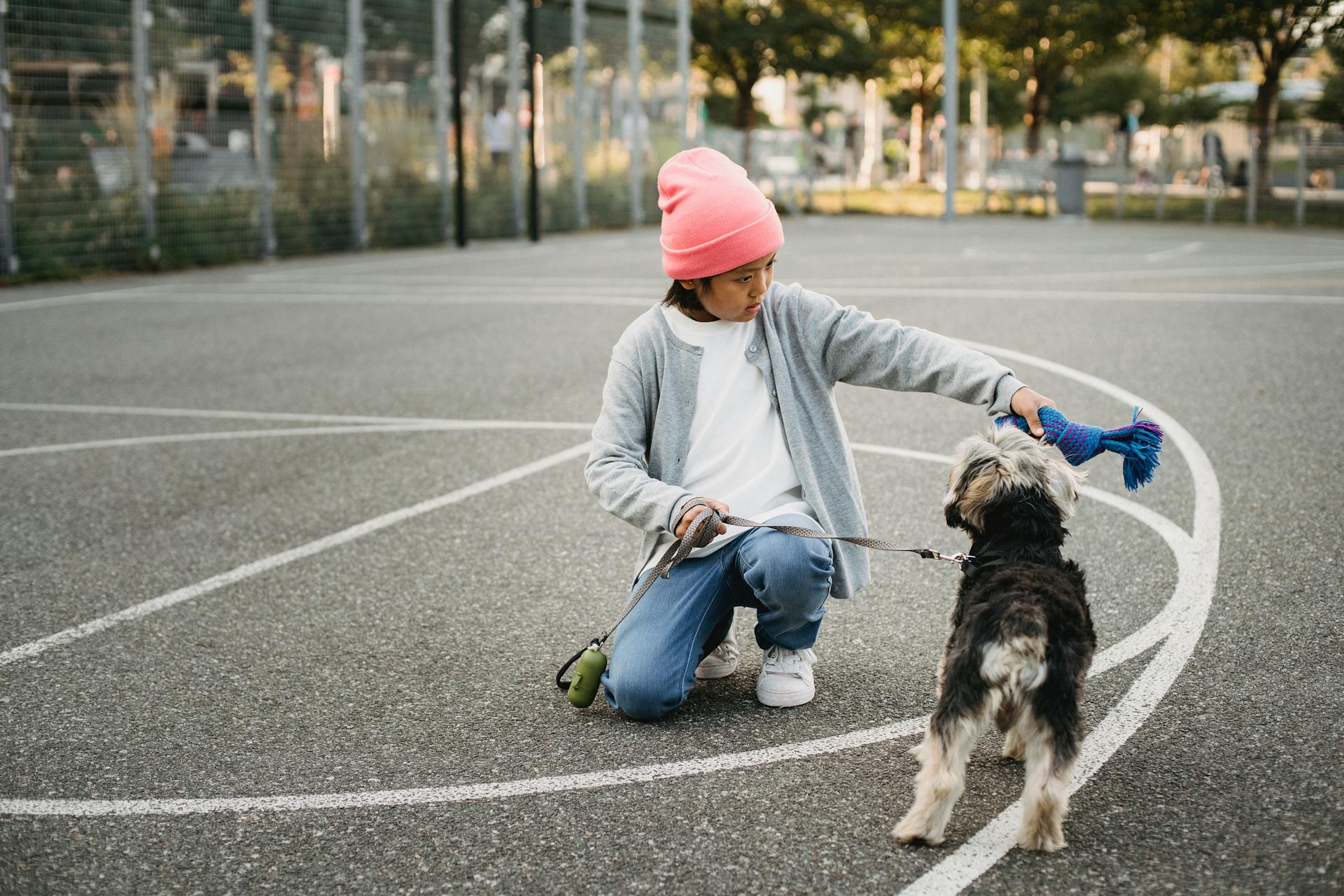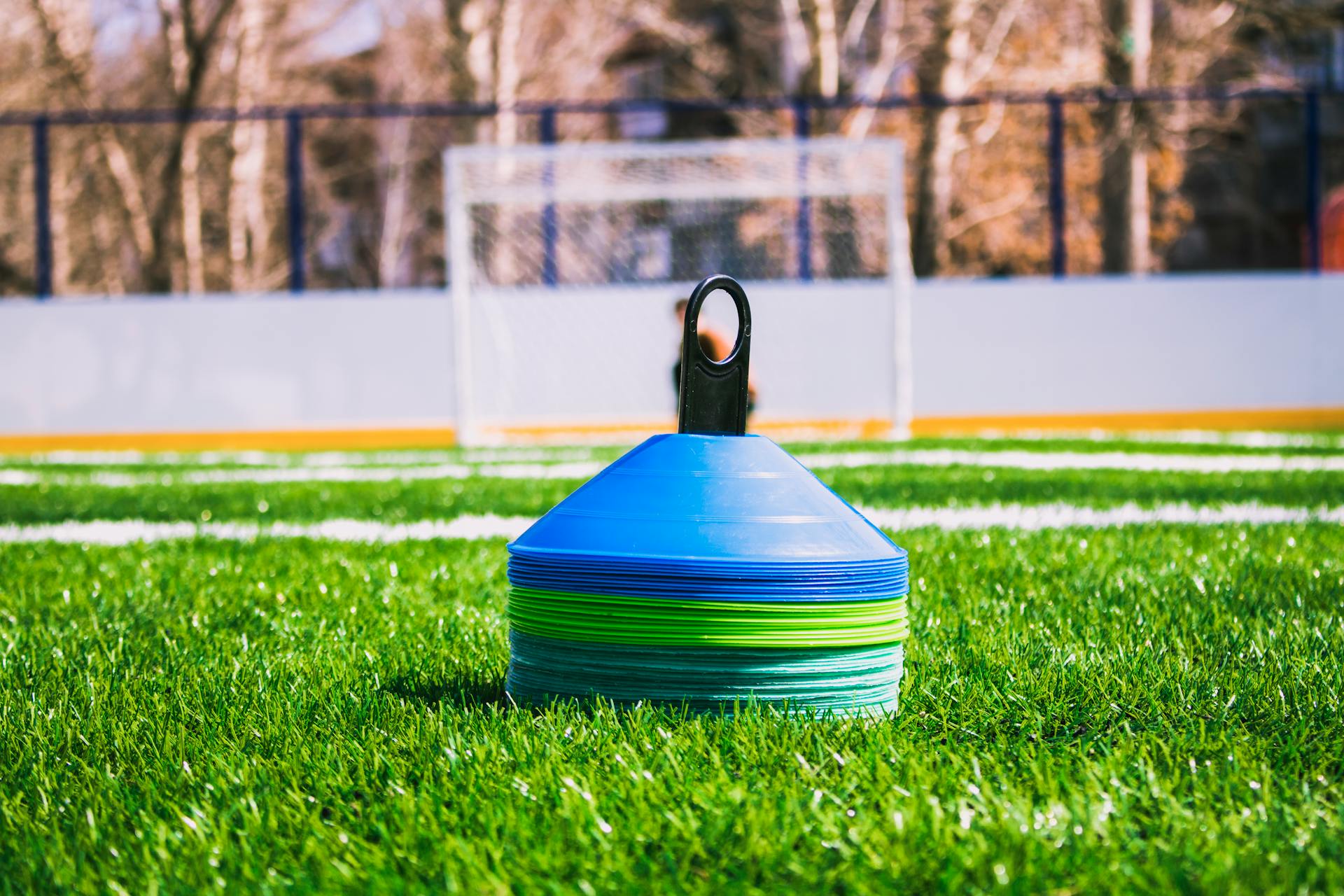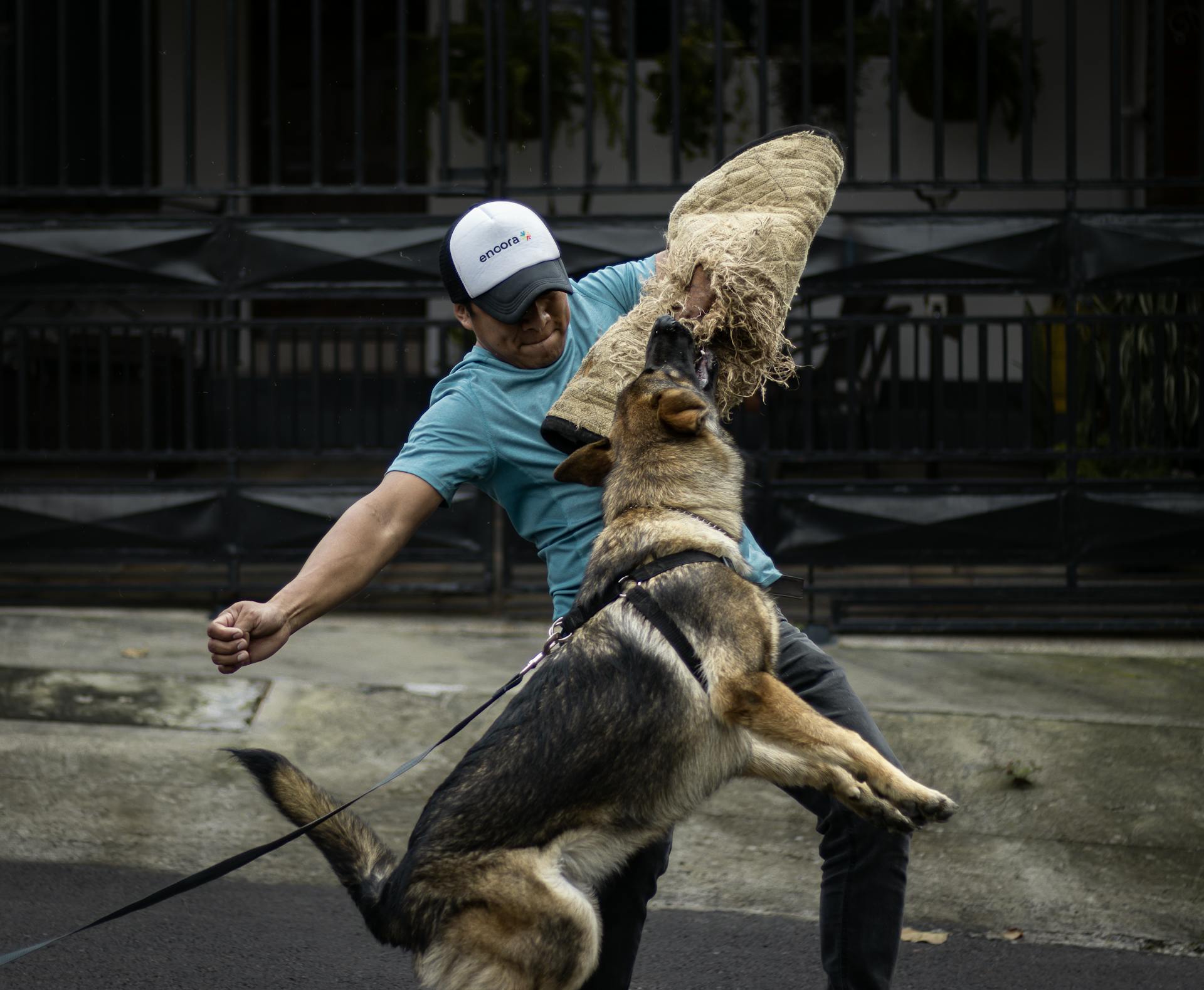
Schutzhund training is a rigorous and rewarding experience that requires dedication and hard work. It's a German word that translates to "protection dog", but it's not just about training a dog to be aggressive.
The training process typically begins with the puppy's socialization phase, which is crucial for developing good behavior and a strong bond with the owner. This phase usually starts at around 8 weeks old.
Schutzhund training is divided into three parts: tracking, obedience, and protection. Tracking involves training the dog to follow a specific scent, obedience focuses on teaching the dog to respond to commands, and protection teaches the dog to defend its owner.
The protection phase is often the most challenging part of the training process, but it's also the most rewarding. It requires the dog to be confident and calm in the face of a stranger or a threatening situation.
You might enjoy: American Schutzhund
What is Schutzhund
Schutzhund is a German word that translates to "protection dog", but it's not just about aggression. It's a comprehensive training method that evaluates a dog's intelligence, athleticism, and obedience.
Schutzhund was developed in Germany in the late 19th century and is based on a dog's natural instincts. The sport involves three main components: tracking, obedience, and protection.
The tracking component requires a dog to follow a scent trail, which can be up to 5 miles long. They must identify the source of the scent, even if it's been disturbed.
A Schutzhund dog must be able to perform a variety of tasks, including fetching and returning a dumbbell, and navigating an obstacle course.
For another approach, see: Schutzhund Classes
Training and Trials
Training for Schutzhund is a hands-on process that takes place in clubs with experienced handlers and dogs. This is where you'll find the best training resources, and it's essential to join a reputable club to get the most out of your training.
A good Schutzhund club is crucial for training, and in the US, most clubs are affiliated with organizations like the American Working Dog Federation (AWDF) or the United Schutzhund Clubs of America (USCA). These clubs usually have a small membership, around 20 or fewer members, due to the limited number of dogs that can be trained in one session.
Schutzhund clubs provide specialized resources for training the protection phase, but they also offer limited formal assistance with tracking and obedience. Experienced members may be willing to help novice handlers with these phases, but this is typically informal.
Traits of Dogs
A dog's character traits are just as important as their physical abilities when it comes to working tasks. Schutzhund tests for traits like a strong desire to work, courage, intelligence, trainability, and a strong bond to the handler.
Dogs that excel in Schutzhund have a protective instinct and a good sense of smell. These traits are essential for police-type work, search and rescue, and specific odor detection.
German Shepherds were developed as all-around working dogs, but their working ability started to decline around 1900. Breeders developed Schutzhund to test their working ability and maintain their strong working characteristics.
The German Shepherd is a breed that excels in Schutzhund, but any breed can participate in the sport. In fact, a wide variety of breeds and sizes participate in the beginning levels of Schutzhund, such as the BH level (Companion Dog test) and OB (Obedience).
For your interest: German Dog Training
Trials and Titles
To obtain a Schutzhund title, you and your dog must pass three distinct phases at a trial: tracking, obedience, and protection. A passing score in all three phases is required to earn a title and advance to the next training level.
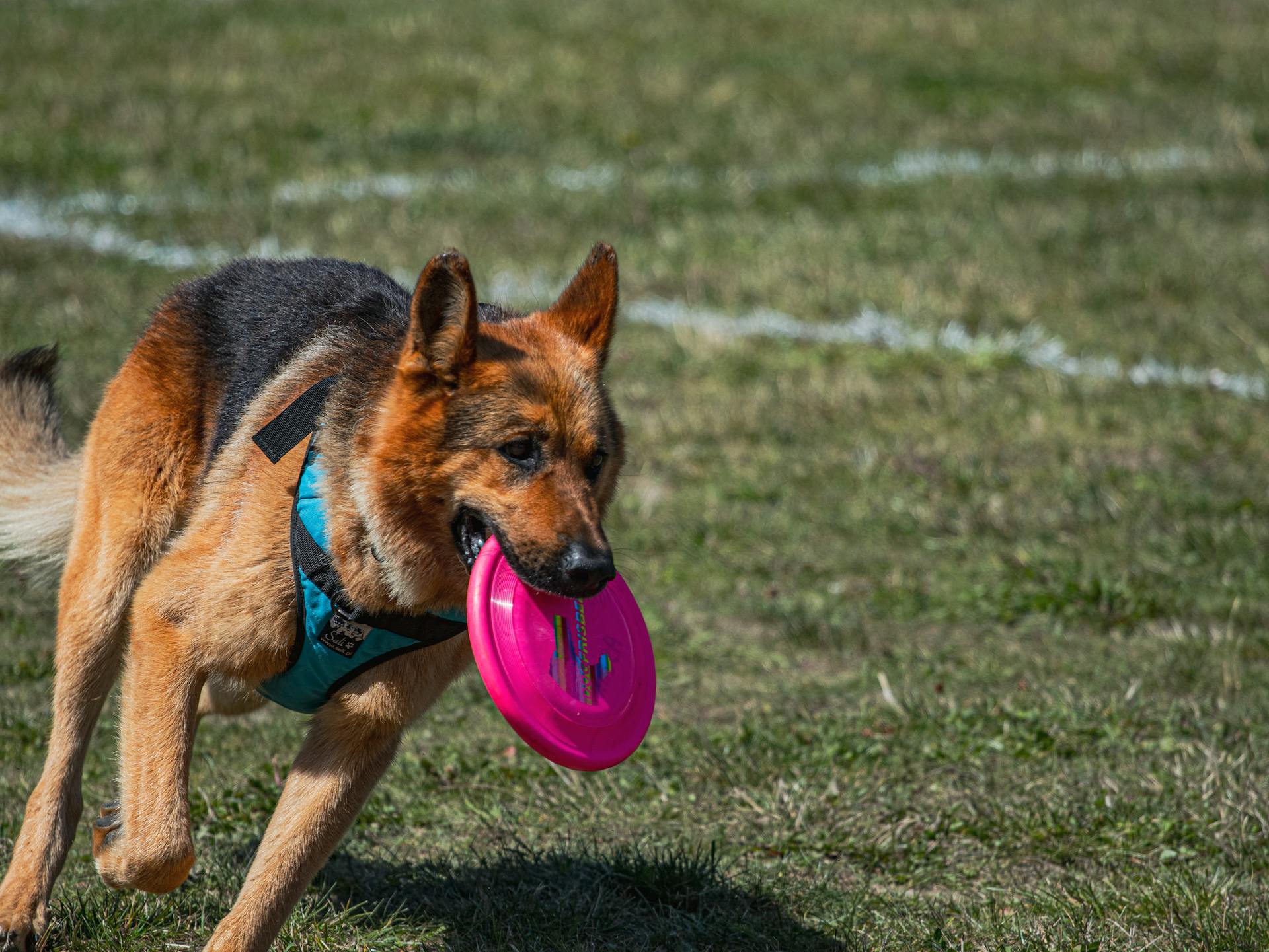
Schutzhund offers three levels of titles: SchH 1 (novice), SchH 2 (intermediate), and SchH 3 (advanced). To earn a title, you and your dog must pass three phases at a trial. Two advanced tracking degrees are also offered: FH and FH2.
A perfect score in each phase is 100 points, with a minimum of 70 needed to pass. Schutzhund clubs hold public trials, providing the opportunity for dogs to earn titles and for handlers to assess their training progress.
Here are the Schutzhund titles:
- SchH 1 (novice)
- SchH 2 (intermediate)
- SchH 3 (advanced)
- FH (advanced tracking)
- FH2 (advanced tracking)
Training Resources
If you're interested in learning more about Schutzhund training, there are many excellent resources available. Col. Konrad Most's Dog Training: A Manual, 1910, is a foundational text that describes Schutzhund training in its early years.
Some of the more influential books on Schutzhund training include Training the Competitive Working Dog by Tom Rose and Gary Patterson in 1985, and Schutzhund Obedience: Training in Drive with Gottfried Dildei, by Sheila Booth, 1992. These books offer valuable insights into the sport.
Dr. Dietmar Schellenberg's book, Top Working Dogs, A Schutzhund Training Manual, published in 1981, presents a comprehensive guide to Schutzhund training and theory.
Books and Materials
Col. Konrad Most's book "Dog Training: A Manual" (1910) is a foundational text on Schutzhund training, but its methods may seem harsh by modern standards.
The book "Der Schutzhund" by Helmut Raiser (1981) marked a significant shift in Schutzhund protection training, moving away from brutal techniques.
In 1981, Dr. Dietmar Schellenberg published "Top Working Dogs, A Schutzhund Training Manual", providing a comprehensive guide to Schutzhund training and theory.
Susan Barwig and Stewart Hilliard's book "Schutzhund Theory & Training Methods" (1991) introduced new ideas to US Schutzhund training.
Tom Rose and Gary Patterson's book "Training the Competitive Working Dog" (1985) is another influential publication on Schutzhund training.
Gary Patterson's book "Training the Behavior: Tips, Techniques and Theory for the Working Dog Trainer" (2006) offers insights into training working dogs.
Sheila Booth's book "Schutzhund Obedience: Training in Drive with Gottfried Dildei" (1992) explores the intersection of obedience and drive in Schutzhund training.
Videos and DVDs have become a popular resource for Schutzhund training information, but it's essential to exercise discretion when evaluating techniques.
Organizations
The organizations involved in Schutzhund can be a bit overwhelming, but don't worry, I've got you covered. The Fédération Cynologique Internationale (FCI) is the international organization that publishes the rules for IGP titles.
The FCI is based in Belgium, and it's a crucial part of the Schutzhund world. The Verband für das Deutsche Hundewesen (VDH) is the national-level all-breed kennel club of Germany, and it's a member-club of the FCI.
Here's a list of some of the key organizations involved in Schutzhund:
In 2004, the Verein für Deutsche Schäferhunde (SV) and the Deutscher Hundesportverein (DHV) made significant changes to Schutzhund, adopting FCI rules that govern IPO titles.
Putting It Together
Schutzhund is a sport that's fun for both the dog and the trainer, challenging and rewarding. It's a unique test of a dog's temperament, where they must prove themselves in three different phases in one day.
The true temperament test of Schutzhund isn't about points or how tough the dog is, but about how well they put it all together. This means demonstrating level of training, guideability, self-confidence, courage, sovereignty, and nerve soundness on a strange field with a strange helper.
A dog who comes out strong and full of themselves, shows joy in the work yet is still controlled and precise, is truly awesome. They've learned to control their drives and urges through obedience, which is a testament to their working temperament.
By the time a dog reaches the trial field, especially by SchH3, they've had countless hours of training, repetition, stress, problem-solving, and handler mistakes. This is where their true character shines through.
Frequently Asked Questions
Can any dog learn Schutzhund?
Any dog can learn Schutzhund, but it was originally developed for German Shepherds. Other breeds can participate, but they must meet specific requirements
What is Schutzhund training called now?
As of 2024, Schutzhund training is now officially known as IGP (Internationale Gebrauchshund Prüfung). This change reflects the sport's evolution beyond its original breed-specific purpose.
Are police dogs trained in Schutzhund?
Police dogs are often bred from Schutzhund lines, but they are not necessarily trained in Schutzhund. Instead, they undergo specialized training for their specific roles, such as narcotics detection or explosives detection.
Featured Images: pexels.com
